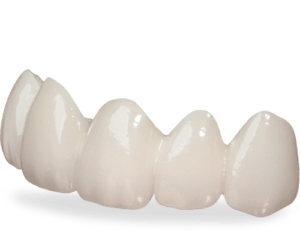Affordable Dental Bridges
A dental bridge is a construction that serves to compensate for missing teeth. For this construction, it is important that there are strong and healthy surrounding teeth that will serve as anchors. Teeth that are used as anchors will have crowns on them and they will carry other porcelain teeth between themselves. All this is connected in a perfect aesthetic and functional structure so it can not be seen that the tooth between the two anchors does not actually exist. The bridge participates in chewing equally well as your natural teeth, and it aesthetically fits your smile.

Types of Dental Bridges
Traditional Bridges are the most commonly used bridges. To have them made, it is necessary that the teeth anchors are reshaped and drilled the same way as for the crown. Those teeth have porcelain teeth that are missing between them.
Maryland Bonded Bridges consists of a porcelain crown that compensates for the missing tooth, and this tooth is attached by porcelain wings to two adjacent teeth. These adjacent teeth are not reshaped as anchored teeth for a traditional bridge. They only have a small place made for porcelain wings to fit in them.
Cantilever Bridges are made when there are no two teeth that could carry the bridge between themselves, but only one tooth is used. This is not an ideal situation, because such bridges are not durable. But in some cases, it is possible to make them, when the forces on these teeth are not large. However, in a situation where we believe that the bridge will not last for a long time, patients are advised to install the implant as a long-term and safe solution.
Implant-Supported Bridges is similar to a traditional bridge, only the anchors are not your teeth, but the dental implants. We will advise what kind of implant you need and tell you everything about the procedure of placing them. Between these two built-in implants, there is a bridge that has equally good functional features as well as a bridge on your teeth.
Post-Operative Instructions
- In the first 24 hours after cementing the new bridge be careful on how you chew your food. If you feel any discomfort while eating, contact us immediately in order to resolve this. Also, try to avoid very hard or sticky food for the first 24h.
- In the first few days, you can experience some tooth sensitivity. Also, the sensitivity of the gums along the crown is possible. This is a normal effect and you do not have to worry about it.
- As well as after any procedure in the dental office for which you received local anesthesia, after cementing the bridge do not eat and do not bite your lip until the effect of anesthesia pass.
- After cementing the bridge, maintain a normal oral hygiene with a brush and a toothpaste. Also, be sure to use dental floss and interdental brushes.
